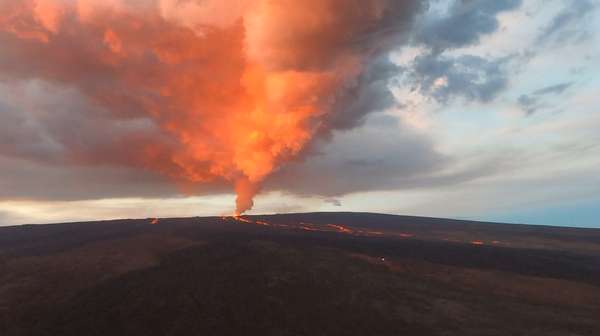The Saddle Road is toast.
A photo from earlier in the eruption, from an overflight the morning of November 30, 2022. USGS image by K. Mulliken.
I don’t hear a lot of folks talking about it, but the way
the Mauna Loa eruption is going, the cross-island Daniel K. Inouye Highway within
days will be impassable going east and west.
That has huge implications for passenger and supply
transport between the Hilo side of Hawai’i Island to the east, and the Waimea
and Kona side to the west. But it also has import for high-elevation science.
The main lava flow has already cut off access to the critical scientific center, Mauna Loa Observatory, and on its current course, it also has the potential to shut down access to the massive astronomy facilities at Mauna Kea.
Judging from the topography, the east-west access will be gone
before Mauna Kea access is threatened.
Mauna Loa may do what the Mauna Kea protests could not.
Mauna Loa’s eruption is currently focused on the northeast
flank. A feature called Fissure 3 is feeding a long lava flow headed northward into
the saddle between Mauna Kea and Mauna Loa.
It is in familiar territory for Madame Pele, with a 1935
flow on its right flank and an 1843 flow on its left. Both of those flows
crossed the current route of the Daniel K. Inouye Highway.
The 1935 flow pooled in the saddle for a few days, then
turned east and headed downslope for Hilo. The Air Force in late December 1935
bombed that flow to try to protect Hilo. Ultimately, that eruption stopped
before Hilo could be impacted. Here is a National Park Service story on that.
It lasted from November 21, 1935 to January 2, 1936. Eight weeks.
The 1843 flow lasted three months.
This eruption started November 27, 2022, and shows no signs
of stopping. The lava is now on pretty flat ground, less than two miles from
the highway, and creeping forward at give-or-take 1,000 feet per day. But that
could change.
The Hawaiian Volcano Observatory reports: “Lava flow advance
rates may be highly variable over the coming days and week. Lava flows advance
more slowly, spread out, and inflate on the flat ground between Mauna Loa and
Mauna Kea. Individual lobes may advance quickly, and then stall. Additional
breakouts may occur if lava channels get blocked upslope. There are many
variables at play, and the direction and timing of flow advances are expected
to change over hours to days, making it difficult to estimate when or if the
flow will impact Daniel K. Inouye Highway.”
Realistically, things that can save the highway from
being overflowed are an early stop of the eruption, or the activation of an
entirely new fissure that allows the current flow to cool and harden in place.
© Jan TenBruggencate 2022










No comments:
Post a Comment